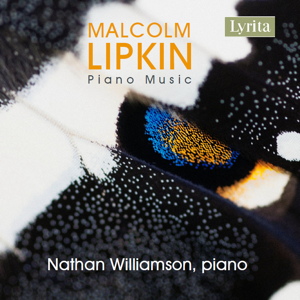
Malcolm Lipkin (1932-2017)
Piano Sonata No 5 (1986)
Piano Sonata No 6, Fantasy Sonata (2002)
Eight Nocturnes (1987-2006)
Nathan Williamson (piano)
rec. 2021, Wyastone Leys, Monmouth, UK
Lyrita SRCD414 [689]
The music of British composer Malcolm Lipkin here takes its turn to receive further attention. This is all the more to be appreciated as the catalogue is not exactly awash with Lipkin records. There is the earlier Lyrita of the three symphonies (review; review) – all of which works predate these piano scores. That pillar of a disc was issued while the composer was still alive. You might conceivably have seen or heard of Hyperion’s LP (A66164) of his chamber music (Clifford’s Tower, String Trio, Pastorale). Usefully this has been reissued on CD alongside other Lipkin works on “Recollections” Divine Art. The three movement ‘suite’ From Across La Manche (1998) is on a Naxos string orchestra disc and its existence is to me almost as astonishing as Lutyens’ En voyage. There was a harvest of BBC Third Programme/Radio 3 broadcasts in the 1950s and 1960s: Mosaics conducted in Wales by John Carewe, a Movement for Strings with the Northern Sinfonia/Myer Fredman, a Piano Concerto with the composer and the BBCSO/Rudolph Schwarz, and a well regarded Violin Concerto No 2 dedicated to and played by Yfrah Neaman alongside the Bournemouth Symphony Orchestra/Constantin Silvestri. Then, after too long a hiatus, Edward Downes in 1983 conducted the BBC Philharmonic in Lipkin’s Symphony No 2 The Pursuit. So far as I can tell little has been broadcast since then, although there is a BBC-requested Oboe Concerto (1989) which carries the words ‘Remembering Cambodia and the millions who died.”
Adrian Farmer of Lyrita, with the collaboration of Jonathan Lipkin, now somewhat redresses the balance with the present disc. We may be left wondering about the earlier piano sonatas (1-4) but the present recital, from a two decade period (1987-2006), encourages, stirs the heart and the grey cells. The music is not particularly tough or unforgiving.
The Eight Nocturnes were written over a twenty-year spell. They come from between the composer’s 55th and 74th years, a period that fell a decade or so before the composer’s death. They are fairly akin in sound and ‘feel’ with arching instances of a slowly paced moonlit voyage. There is also a dash of harmonic complexity rather than dissonance. The First recalled for me the intense music of the Frank Bridge sonata. The Second is notable for its slow chiming relaxed by a seeming evocation of a pebble flipped into waters that are still and deep. The tolling carries over into the Third that moves from slow and stable to an ambling gait. The pierrot-style desolation of the Fourth recalls the earlier scores of Sorabji complete with a pearly tinkling. The Fifth is velvety and its ‘line’ is dysjunct, offset by a figure that suggests a pirouette and finally a benevolence that steps out of the shadows. Its successor is more mosaic and angular yet moth-wing gentle. It had me thinking of the glimmering starry night skies beloved of the Estonian composer, Urmas Sisask (1960-2022). The Seventh is more assertive, even belligerent, while the last in the sequence has material that is stimulating and jazzy. Not for the last time was I to recall the back-street Marseille musics of Constant Lambert’s Piano Sonata.
The two-movement Sonata No. 5 from about the same period as the First Nocturne is marked ‘Extremely Slow’ but quite a portion is inspiringly rapid, even recalling the slamming chords of Antheil and Ornstein. The final movement also picks up speed and urgency but in a way that again seems to look towards Lambert and his Sonata. The Sixth Sonata – the longest piece here – is cloud-hung but weaves this mood into music that ponders yet avoids the ponderous. There is drama yet again and this aspect places the work alongside the much earlier Piano Sonata by Howard Ferguson.
Throughout all this music Nathan Williamson bring conviction, technical prowess and a sense of direct connection with the composer.
The notes for the present CD are by Paul Conway and are very much to the point. They extend, to good substantive effect, over eight pages. They ensure that the reader, well served, gains a perspective on Lipkin’s life; likewise the background to and structure of the works. The cover takes us back to a distant echo of those Keith Hensby abstract designs that used to grace Lyrita’s LP sleeves.
Rob Barnett
Help us financially by purchasing from

Contents
Nocturne No. 1 (1987 rev 2000) [6:56]
Nocturne No. 2 (1995) [5:38]
Nocturne No. 3 (1995) [4:31]
Sonata No. 5 (1986) [13:10]
Nocturne No. 4 … heard in the stillness … (2000) [5:22]
Nocturne No. 5 … interrupted melody … (2001) [4:30]
Sonata No. 6 Fantasy Sonata (2002) [15:06]
Nocturne No. 6 … glint and shadow … (2002) [4:30]
Nocturne No. 7 … dancing figures … (2004) [4:40]
Nocturne No. 8 … recollections … (2006) [4:25]


















